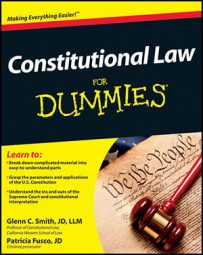Identifying current U.S. Supreme Court justices
The justices on the Supreme Court interpret the Constitution, which affects everyone in this country. As you study constitutional law, knowing the justices and their interpretive styles helps you make sense of big decisions and predict future outcomes.
Chief Justice:
-
John G. Roberts: Born 1955, seated on the Supreme Court 2005 (appointed by President George W. Bush)
Associate Justices:
-
Clarence Thomas: Born 1948, seated on the Supreme Court 1991 (appointed by President George H. W. Bush)
-
Stephen G. Breyer: Born 1938, seated on the Supreme Court 1994 (appointed by President Bill Clinton)
-
Samuel Anthony Alito, Jr.: Born 1950, seated on the Supreme Court 2006 (appointed by President George W. Bush)
-
Sonia Sotomayor: Born 1954, seated on the Supreme Court 2009 (appointed by President Barack Obama)
-
Elena Kagan: Born 1960, seated on the Supreme Court 2010 (appointed by President Barack Obama)
-
Neil M. Gorsuch: Born 1967, seated on the Supreme Court 2017 (appointed by President Donald Trump)
-
Brett M. Kavanaugh: Born 1965, seated on the Supreme Court 2018 (appointed by President Donald Trump)
- Amy Coney Barrett: Born 1972, seated on the Supreme Court 2020 (appointed by President Donald Trump)
Analyzing a procedural due-process claim
Procedural due process involves the way the government goes about infringing on Americans’ rights. Procedural due-process cases assume that the government is constitutionally allowed to take away a right. (Substantive due process questions whether the government has that right in the first place.)
In these cases, the courts consider two questions that determine constitutionality: (1) Was adequate notice given? and (2) Did the person have an opportunity to be heard?
A two-part analysis determines whether the government has afforded adequate procedural due process under the Constitution:
-
Is any process due?
That is, have the people making the challenge established that they were even deprived of a legitimate property or liberty?
-
If process is due, how much?
This balancing test weighs how important the person’s right is and how important the government’s interest is, as well as what the risk is of depriving someone wrongfully with the present procedures as opposed to having additional or different procedures.
Analyzing a substantive due-process claim
Substantive due process involves whether the government has a legitimate basis for taking away a person’s right to life, liberty, or property. The basic question is, “Wait — does the government have a right to do this at all?”
In substantive due-process cases, the courts use a baseline rationality test that considers: (1) Is the government’s interest legitimate? and (2) Is the government’s action a means to a legitimate end?
Important rights listed in the constitution
The Constitution is chock-full of guarantees of individual rights and rules about what the government can and can’t do. Some provisions affect people’s lives more than others, but they are all important in their own right. Here are just some of the important, often-discussed provisions and where you can find them in the Constitution:
-
Freedom of speech, press, and religion: First Amendment
-
Right to bear arms: Second Amendment
-
Right to be free from unreasonable searches and seizures: Fourth Amendment
-
Right against self-incrimination and double jeopardy: Fifth Amendment
-
Due process: Fifth and Fourteenth Amendments
-
Right against taking without just compensation: Fifth Amendment
-
Right to a speedy and public trial: Sixth Amendment
-
Right to counsel: Sixth Amendment (also read into the Fifth-Amendment right against self-incrimination)
-
Prohibition against cruel and unusual punishment: Eighth Amendment
-
Slavery abolishment: Thirteenth Amendment
-
Equal protection: Fourteenth Amendment
-
Women’s right to vote: Nineteenth Amendment
-
Commerce clause: Article I, Section 8
-
“Necessary and proper” clause: Article I, Section 8
-
Contracts clause: Article I, Section 10
-
Full faith and credit: Article IV, Section 1

